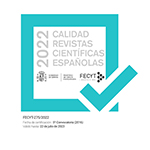Utopía y Ucronía: Galicia triunfante en el Noreste (2016) de Daniel Asorey
Resumen
Miguel-Anxo Murado en el ensayo Outra idea de Galicia (2016) cuestiona el mito de la tierra sin historia utilizado para explicar el borrado de la importancia de la historia gallega en Europa. Murado atribuye el problema a los historiadores y a las prioridades de quienes, al escribir la historia de España, relegan al olvido la mayoría de los episodios gallegos. En línea con este análisis y basándose en la tesis de Walter Benjamin (1996), la novela Nordeste (2016) de Daniel Asorey utiliza la utopía y la ucronía para promover una reparación histórica de la tierra gallega. En esta novela, el autor cepilla la historia a contrapelo y, además, cambia la trayectoria histórica de Galicia creando una trama de ficción que pretende dar respuesta a la pregunta: “¿Qué le habría pasado a Galicia y al mundo si los gallegos hubieran tenido éxito en la Guerra Irmandiña?”. Murado, en su ensayo, llega a la conclusión de que historia y poder son sinónimos y ese poder es restituido por Daniel Asorey al imaginar una Galicia utópica, colonizadora e imperialista, poseedora de colonias en Brasil. Nordeste es una obra que busca restaurar la voz silenciada de los subalternos y sumisos, los perdedores de las narrativas históricas, según el pensamiento benjaminiano. Este libro manipula la historia y el tiempo a través de la conexión de cuatro personajes femeninos: Maria Bonita, la reina del movimiento cangaço brasileño; Carme de Candigas, una personaje ficticio y Matilda, la gallega emigrada a São Paulo, un personaje inspirado en la fotógrafa estadounidense, Mathilda Anderson. La cuarta mujer es la representación femenina de Galicia, pilar de la respuesta imperialista y misógina a los intentos nacionalistas de las naciones celtas atlánticas, dormidas y oprimidas por el imperialismo y el centralismo británico y español.
Descargas
Descarga artículo
Licencia
La revista Madrygal. Revista de Estudios Gallegos, para fomentar el intercambio global del conocimiento, facilita el acceso sin restricciones a sus contenidos desde el momento de su publicación en la presente edición electrónica, y por eso es una revista de acceso abierto. Los originales publicados en esta revista son propiedad de la Universidad Complutense de Madrid y es obligatorio citar su procedencia en cualquier reproducción total o parcial. Todos los contenidos se distribuyen bajo una licencia de uso y distribución Creative Commons Reconocimiento 4.0 (CC BY 4.0). Esta circunstancia ha de hacerse constar expresamente de esta forma cuando sea necesario. Puede consultar la versión informativa y el texto legal de la licencia.








